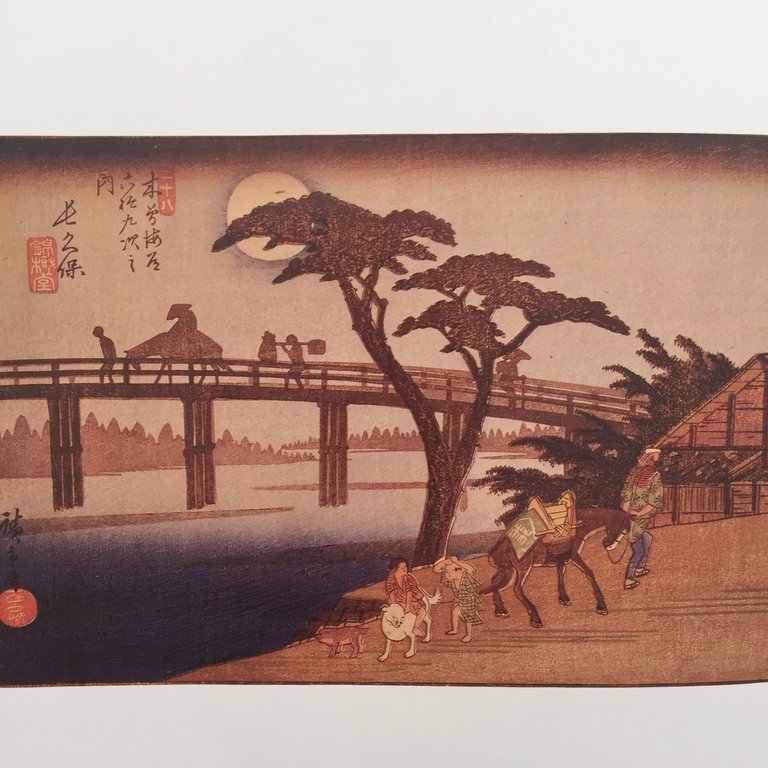The famous artist Ando Hiroshige was born in 1797 in Edo, the ancient capital of Japan. His father was the samurai Ando Genamon, who was the foreman of the city's fire brigade. The first name that Hiroshige received as a child was Tokutaro. According to the ancient Japanese custom (to protect the child from bad predictions) his name changed several times as he grew up. After ten years, Tokutaro was renamed Tokbei, in fourteen - in Jujuemon, after fifteen - in Dzubey.
To learn hieroglyphic writing Tokuraro began, as was customary, quite early, thanks to which already from his youth he began to understand the properties of paper, brushes and ink. The first lessons of painting Hiroshige received from one of his father's colleagues, and wrote his first painting "Mount Fuji in the snow" at ten years old. Parents were proud of the success of his son, but they did not see the flowering of his talent: both the father and the artist's mother died one year, and at thirteen years Hiroshige became an orphan.
In accordance with the existing order, Hiroshige inherited from his father the post of fire brigade leader, but this occupation was contrary to his interests. At the age of fifteen, he enrolled to Toyohiro Utagawa, one of the largest Japanese masters of ukiyo-e engraving, who mainly worked in the "bidding" genre, specializing in portraits of beauties. As a rule, the training process lasted four to five years. Obligations of the student were strictly stipulated. In addition to helping the master in his work, the student had to carry out errands for the household. This period Hiroshige passed in one year, after which he received a diploma of master engraving. But in his teacher's house Hiroshige was still several years old. Later, the formation is typical for most famous Japanese artists of the time. Before starting their independent work, they studied the laws of classical painting for many years, copied the work of their teacher many times, comprehended various methods of work with a brush. Mastering all the "Ukiyo-e" genres was an indispensable condition for the beginning of independent creativity. As a rule, famous Japanese masters came to the heights of art rather late, and some - even in old age (for example, Hokusai created his best paintings in sixty years). Stylistics Hiroshige was formed to thirty-five years.
The first independent landscape series Hiroshige refers to 1825 and is called "Eight kinds of Omi." The young master's appeal to landscape engraving came not without the influence of the landscape series of Hokusai, which appeared in Edo bookstores two years earlier. In 1827, Hiroshige again turned to the landscape, this time choosing as his object his native city of Edo. So the series "Ten kinds of the Eastern capital" was born (Edo is located to the east of Kyoto, where the emperor's residence was). Already the first released series enjoyed a certain popularity, but the real glory came to Hiroshige after the publication of the series "Fifty-three stations of the Tokaido road".
The military government in Edo had the custom of sending a white horse to Kyoto every year. This symbolic gift was accompanied by a lot of samurai. The procession moved slowly from Edo to Kyoto along the east-seaside road - Tokaido. In 1832, Hiroshige took part in this procession, making notes on the road diary at each station. In late 1833, he released a series of "Fifty-three stations of the Tokaido road." The first two hundred copies of it were sold out in a matter of weeks. The success of the engravings contributed to the fact that in 1834 the publisher, with which Hiroshige collaborated, re-released this series as an album. Thus, the name of the artist became gradually known throughout Edo.
The middle of the 1830s became the most fruitful period in the life of Hiroshige. But he ended tragically: in 1839 the first wife of the artist died. Soon he married again. Documentary evidence suggests that the master in the 1840s had a constant concern, aggravated also by the death of his son Tyudziro. He made long trips around the country, often moved from place to place and only at the end of the decade, returned to his own two-story house with a garden. Here he had an extensive workshop, students and assistants, but Hiroshige was burdened with teaching. He could not be a good teacher, for he above all else valued the minutes of contemplative solitude. Nevertheless, at different times he had about two dozen students.
In 1849, after the death of Hokusai, Hiroshige became the most famous Japanese landscape painter. A lot of orders that were being executed at that time deprived him of time for concentrated contemplation and searching for precise expressive means. Hiroshige's engravings of these years often leave much to be desired, and the artist himself probably realized that he was not experiencing the best creative period. During these years, he often spoke of his desire to break with art, "before years and weariness disgrace his former glory."
In 1856, Hiroshige took the monastic vows and became a monk living in the world. To this decision, he walked for a long time, in 1847, having chosen the fate of a novice. The artist died in 1858, probably during a cholera epidemic. He was buried next to the graves of his parents in the Togakuji temple.
